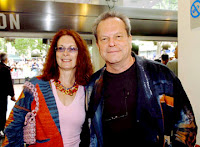In all movies we can find the language of film, which helps us to understand in a better way how the movie was constructed with all the technical aspects such as; setting, make up, camera angle, and costumes, among others. It is important to define the main concepts related to film.
The Language of film has four main areas:
Mise-en –scene: It is everything in the screen. This is, at the same time, divided in six sub-areas:

A. setting (set and props)
B. acting (people)
C. costumes
D. make up
E. lighting
F. print (diegetic and non-diegetic)
According to this area, in our movie “Brazil”, we can see that the setting is London in the 80’s, but it is a futuristic vision of the word. There are a lot of technological props; everything is made in function of technology.
The actors and actresses are nowadays famous and with a great career, especially Robert Deniro. Their performances are good and credible what make the audience get involve in the story.
The costumes and the make up were very similar in all characters, like uniforms, but sometimes the director tried to exaggerated certain things or elements such as the mother of the protagonist, who passed for a series of surgeries, so Gilliam tried to show this by using a lot of make up.
About the lights, we can say that it was dark throughout the whole movie, this gave an impression of a dark place in the protagonist’s mind.
When it comes to the prints, there is diegetic and non-diegetic. Diegetic; for example is everything that the characters read like menus, papers, signs, among others. Non-diegetic are the credits.
Sound: It is formed by music, dialogues and silence. Music is very important in the movie because we can hear the soundtrack of Brazil, a popular song , that reminds us of a nice, sunny place, just what the main character wants.
Editing: It is formed by fade in , disolve, jump cut, among others. It is a technical aspect that we did not pay too much attention. We notice that there were fade in and cross fade. The shots did not have any unusual type of editing. We think it was not the main focus of the director.
 Cinematography:
Cinematography: It is the camera angle that the director uses. This is where the camera goes. There are a lot of types, some of this are: high, low, straight, and aerial. There are also camera distance (deep, shallow), extreme long shot, medium shot, close up, among others. In the movie we can see all of these develop in an excellent way, the audience sees just what the director wants to be the main focus, he controls what we see.






































